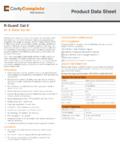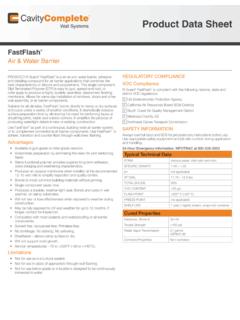Transcription of Product Name: MARTIN DECKER W15 MATERIAL SAFETY …
1 Product name : MARTIN DECKER W15 Revision Date: 07 Oct2005 Page 1 of 9 _____ MATERIAL SAFETY DATA SHEET SECTION 1 Product AND COMPANY IDENTIFICATION Product Product name : MARTIN DECKER W15 RED Product Description: Base Oil and Additives Product Code: 431007-00, 97Q043 Intended Use: Hydraulic/transmission fluid COMPANY IDENTIFICATION Supplier: EXXON MOBIL CORPORATION 3225 GALLOWS RD. FAIRFAX, VA. 22037 USA 24 Hour Health Emergency 609-737-4411 Transportation Emergency Phone 800-424-9300 ExxonMobil Transportation No. 281-834-3296 MSDS Requests 713-613-3661 Product Technical Information 800-662-4525, 800-947-9147 MSDS Internet Address , SECTION 2 COMPOSITION / INFORMATION ON INGREDIENTS Reportable Hazardous Substance(s) or Complex Substance(s) name CAS# Concentration* HYDROTREATED LIGHT NAPHTHENIC DISTILLATE (PETROLEUM) 64742-53-6 80 - 90% POLY LONG-CHAIN ALKYL METHACRYLATE 5 - 10% * All concentrations are percent by weight unless MATERIAL is a gas.
2 Gas concentrations are in percent by volume. SECTION 3 HAZARDS IDENTIFICATION This MATERIAL is considered to be hazardous according to regulatory guidelines (see (M)SDS Section 15). POTENTIAL HEALTH EFFECTS Repeated exposure may cause skin dryness or cracking. Harmful: may cause lung damage if swallowed. Excessive exposure may result in eye, skin, or respiratory irritation. Frequent or prolonged contact may defat and dry the skin, leading to discomfort and dermatitis. High-pressure injection under skin may cause serious damage. Target Organs: Skin | Lung | NFPA Hazard ID: Health: 0 Flammability: 1 Reactivity: 0 HMIS Hazard ID: Health: 0 Flammability: 1 Reactivity: 0 Product name : MARTIN DECKER W15 Revision Date: 07 Oct2005 Page 2 of 9 _____ NOTE: This MATERIAL should not be used for any other purpose than the intended use in Section 1 without expert advice.
3 Health studies have shown that chemical exposure may cause potential human health risks which may vary from person to person. SECTION 4 FIRST AID MEASURES INHALATION Remove from further exposure. For those providing assistance, avoid exposure to yourself or others. Use adequate respiratory protection. If respiratory irritation, dizziness, nausea, or unconsciousness occurs, seek immediate medical assistance. If breathing has stopped, assist ventilation with a mechanical device or use mouth-to-mouth resuscitation. SKIN CONTACT Wash contact areas with soap and water. Remove contaminated clothing. Launder contaminated clothing before reuse.
4 If Product is injected into or under the skin, or into any part of the body, regardless of the appearance of the wound or its size, the individual should be evaluated immediately by a physician as a surgical emergency. Even though initial symptoms from high pressure injection may be minimal or absent, early surgical treatment within the first few hours may significantly reduce the ultimate extent of injury. EYE CONTACT Flush thoroughly with water. If irritation occurs, get medical assistance. INGESTION Seek immediate medical attention. Do not induce vomiting. NOTE TO PHYSICIAN If ingested, MATERIAL may be aspirated into the lungs and cause chemical pneumonitis.
5 Treat appropriately. SECTION 5 FIRE FIGHTING MEASURES EXTINGUISHING MEDIA Appropriate Extinguishing Media: Use water fog, foam, dry chemical or carbon dioxide (CO2) to extinguish flames. Inappropriate Extinguishing Media: Straight Streams of Water FIRE FIGHTING Fire Fighting Instructions: Evacuate area. Prevent runoff from fire control or dilution from entering streams, sewers, or drinking water supply. Firefighters should use standard protective equipment and in enclosed spaces, self-contained breathing apparatus (SCBA). Use water spray to cool fire exposed surfaces and to protect personnel. Unusual Fire Hazards: Pressurized mists may form a flammable mixture.
6 Hazardous Combustion Products: Smoke, Fume, Sulfur oxides, Aldehydes, Oxides of carbon, Incomplete combustion products FLAMMABILITY PROPERTIES Flash Point [Method]: >94 C (201 F) [ ASTM D-92] Flammable Limits (Approximate volume % in air): LEL: N/D UEL: N/D Product name : MARTIN DECKER W15 Revision Date: 07 Oct2005 Page 3 of 9 _____ Autoignition Temperature: N/D SECTION 6 ACCIDENTAL RELEASE MEASURES NOTIFICATION PROCEDURES In the event of a spill or accidental release, notify relevant authorities in accordance with all applicable regulations. regulations require reporting releases of this MATERIAL to the environment which exceed the reportable quantity or oil spills which could reach any waterway including intermittent dry creeks.
7 The National Response Center can be reached at (800)424-8802. SPILL MANAGEMENT Land Spill: Stop leak if you can do it without risk. Recover by pumping or with suitable absorbent. Water Spill: Confine the spill immediately with booms. Stop leak if you can do it without risk. Warn other shipping. Remove from the surface by skimming or with suitable absorbents. Seek the advice of a specialist before using dispersants. Water spill and land spill recommendations are based on the most likely spill scenario for this MATERIAL ; however, geographic conditions, wind, temperature, (and in the case of a water spill) wave and current direction and speed may greatly influence the appropriate action to be taken.
8 For this reason, local experts should be consulted. Note: Local regulations may prescribe or limit action to be taken. ENVIRONMENTAL PRECAUTIONS Large Spills: Dike far ahead of liquid spill for later recovery and disposal. Prevent entry into waterways, sewers, basements or confined areas. SECTION 7 HANDLING AND STORAGE HANDLING Prevent small spills and leakage to avoid slip hazard. Static Accumulator: This MATERIAL is a static accumulator. STORAGE Do not store in open or unlabelled containers. SECTION 8 EXPOSURE CONTROLS / PERSONAL PROTECTION EXPOSURE LIMIT VALUES Exposure limits/standards (Note: Exposure limits are not additive) Source Form Limit / Standard Note Source HYDROTREATED LIGHT NAPHTHENIC DISTILLATE (PETROLEUM) TWA 2000 mg/m 500 ppm N/A OSHA Z1 Product name : MARTIN DECKER W15 Revision Date: 07 Oct2005 Page 4 of 9 _____ Exposure limits/standards for materials that can be formed when handling this Product : When mists / aerosols can occur, the following are recommended: 5 mg/m - ACGIH TLV, 10 mg/m - ACGIH STEL, 5 mg/m - OSHA PEL.
9 NOTE: Limits/standards shown for guidance only. Follow applicable regulations. ENGINEERING CONTROLS The level of protection and types of controls necessary will vary depending upon potential exposure conditions. Control measures to consider: No special requirements under ordinary conditions of use and with adequate ventilation. PERSONAL PROTECTION Personal protective equipment selections vary based on potential exposure conditions such as applications, handling practices, concentration and ventilation. Information on the selection of protective equipment for use with this MATERIAL , as provided below, is based upon intended, normal usage.
10 Respiratory Protection: If engineering controls do not maintain airborne contaminant concentrations at a level which is adequate to protect worker health, an approved respirator may be appropriate. Respirator selection, use, and maintenance must be in accordance with regulatory requirements, if applicable. Types of respirators to be considered for this MATERIAL include: No special requirements under ordinary conditions of use and with adequate ventilation. For high airborne concentrations, use an approved supplied-air respirator, operated in positive pressure mode. Supplied air respirators with an escape bottle may be appropriate when oxygen levels are inadequate, gas/vapor warning properties are poor, or if air purifying filter capacity/rating may be exceeded.







